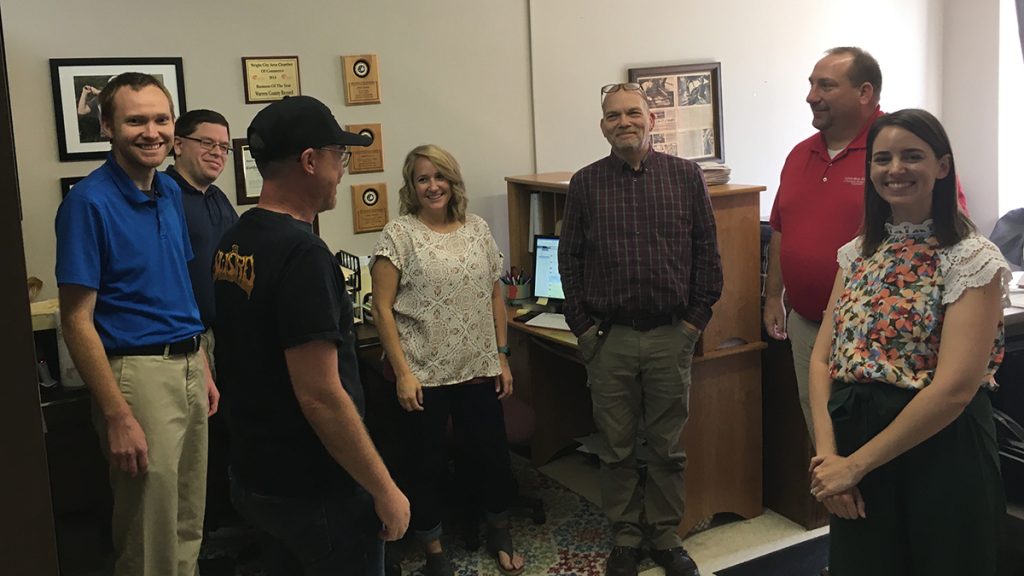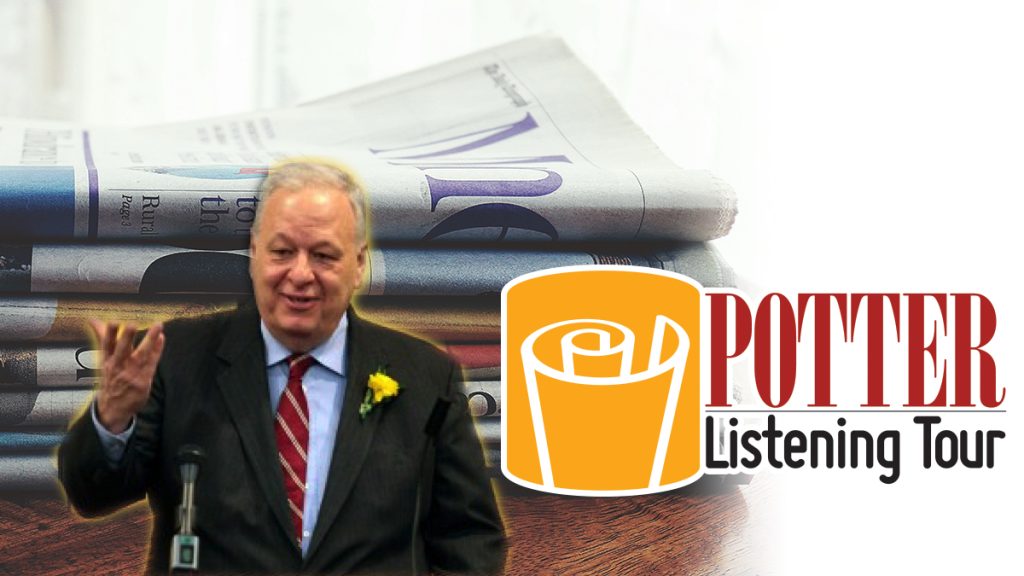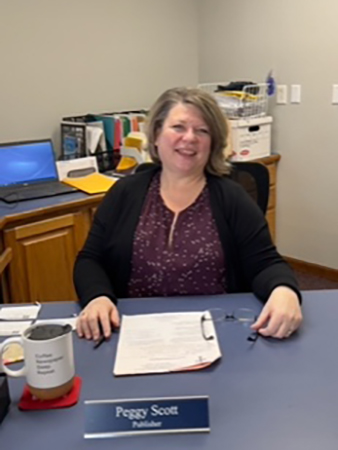
Staff members of Westplex Media Group. Owner Tim Schmidt is second from right.
These newspaper chain owners live where they publish
Local groups buy back community newspapers from big chains and invest in journalism
Walter B. “Walt” Potter Jr. is a retired newspaper executive who in 2010 established the Walter B. Potter Fund for Innovation in Local Journalism at the Reynolds Journalism Institute. Among other initiatives, the fund backs the Potter Digital Ambassadors, which sends Missouri journalism students out to local papers as consultants on new technology.
The horror story of local newspaper decline is well known. For approaching two decades, local news organizations have been closing or sharply shrinking their operations. In turn, the reporters and editors who cover local news have been laid off in the thousands.
The past several years, however, another story has arisen, a sort of Goldilocks tale. Local ownership has been buying back newspapers from big chains and making those acquisitions work by finding the sweet spot between the size of a newspaper group and local control.
From 2005 to May 2022, the U.S. lost about a fourth of its newspapers, shrinking to less than 6,400, according to Northwestern University’s Medill School of Journalism. Newsroom employment shrank even more dramatically, to about 31,000 employees, or less than half its 2005 total.
Amid this shriveling of the industry, many of the newspapers that remained were snapped up by hedge funds and other consolidators. For example, hedge-fund-controlled Gatehouse Media began a $1 billion acquisition campaign after emerging from bankruptcy in 2013. Once they acquired papers, these organizations often laid off reporters, editors and other employees to cut costs, what big companies often call “right-sizing.”
The past several years though, these big companies also shed papers that didn’t fit their plans, often selling to local owners. Small to medium size groups of daily and weekly newspapers across the U.S. have been finding success, even growth, by a new kind of right-sizing: They add employees to increase local news coverage.
Local owners who bought newspapers from chains like Gannett have been able to fix a flaw in big companies’ approach to small community journalism and return to profitability quickly.
“A big, early” example of the trend came in 2016 when local residents bought The Berkshire Eagle in Pittsfield, Massachusetts, from hedge fund Alden Global Capital, recalls Bill Ostendorf, president and founder of Creative Circle Media Solutions. Ostendorf’s consulting firm has made a specialty of helping local owners like those in Pittsfield adapt chains’ one-size-fits-all operations to local needs.
Ostendorf’s business opportunities surged following the late 2019 merger of Gannett and New Media Investment Group, the owner of Gatehouse, into the largest U.S. newspaper owner. At the end of that year, the resulting combination owned 269, or one in five of all U.S. dailies, according to researchers at the University of North Carolina.
But then Gannett started selling off the papers it didn’t want. Poynter Institute reported in July 2021 that just 18 months after the merger with Gatehouse, Gannett had sold 23 papers back to local owners.
Local owners who bought newspapers from chains like Gannett have been able to fix a flaw in big companies’ approach to small community journalism and return to profitability quickly, says Sara April of Dirks, Van Essen & April. The big companies “saw the future in centralizing as many functions as they could” and spreading those functions over fewer employees.
It turned out, however, that only some functions benefited from consolidation, explained April, whose firm handled a number of these sales. “Advertising and editorial has to come from that local place. If you’re writing about local events, local connections make those stories more successful. If you’re selling to Mom and Pop businesses, you can sell more” if you know them rather than trying to do it from a distance.
Even small regional chains are adapting a local emphasis in each of their papers, says April. The result is that “for every Gannett, there are 15 Tim Schmidt’s.”
Schmidt owns Westplex Media Group west of St. Louis. He has built a group of four weeklies since 2018, his last two papers purchased from Gannett. He has more than doubled the staff at the former Gannett properties.
Another example is south of the Gateway City. The Leader Publications has been creating new weeklies as small communities are born and grow in the southern St. Louis suburbs. The Leader, too, is actively looking for new employees, says Publisher Peggy Scott.
Meanwhile, Schmidt and Scott, who each grew up in the same areas where their papers are published, focus heavily on local news. That’s a constant as they manage their print products in an ever increasingly digital world.
Westplex Media grows out of its owner’s experience.
Before Schmidt bought his newspapers, he worked for more than 15 years on both the news and business sides of northeastern Missouri newspapers. He developed ideas while working at those papers that he put into place as an owner.
Since purchasing the Montgomery Standard in 2018 and the Warren County Record in 2019, Schmidt has rejected the large chain approach of forcing individual papers to conform to group-wide back office practices. For example, he doesn’t have dedicated circulation software. Instead, he uses off-the-shelf spreadsheet software and then outsources distribution and printing. For accounting, he uses QuickBooks. Then he pockets the savings.
With Schmidt’s next two purchases, Gannett’s Mexico Ledger and Moberly Monitor-Index, he got help from Ostendorf’s Creative Circle. “In 30 to 60 days, everything from Gannett has to be replaced,” Ostendorf said. “They charge you a lot to stay on Gannett’s system.” Creative built websites for each of Schmidt’s four papers.
The Ledger and Monitor-Index were among a dozen small Missouri papers Gannett shed in just two years. “They wanted the sale to me to be a template” for selling papers that didn’t fit the chain’s national approach, says the young entrepreneur.
But once the new systems were in place, economies of scale could be realized. “We focus on cross selling among our papers,” says Schmidt. “We can run ads in two, three or all four of our papers. The advantage to advertisers is they only have to deal with one salesman and one bill, plus they get a little bit of a discount for running in more papers.”
Since purchasing the Montgomery Standard in 2018 and the Warren County Record in 2019, Tim Schmidt has rejected the large chain approach of forcing individual papers to conform to group-wide back office practices.
There’s also cross-utilization of employees. For example, Westplex Media employs two graphics people who each work for two papers.
The publisher doesn’t just cut costs. He invests in local coverage, more than doubling the staffs of the Gannett papers. That has allowed him to take advantage of a pullback by other papers from covering the area. “The biggest thing is a focus on people to improve our content,” Schmidt says. “We prefer to invest in people.”
How the extra people are used also matters. “To have those relationships with local people takes time,” Schmidt says. “We want people to identify them as being with the newspapers. We want people to know they’re not calling into a call center. Our advantage is we live here.”
Schmidt is working on how best to deliver this local content to his readers. He thinks half of his readership is already commuting from their rural homes to cities and will probably want news on their mobile devices as they do so. As more people move into his area from St. Louis, that number will only grow.
For now, Westplex newspapers are print first. “We have a paywall on our website,” notes Schmidt. But he’s developing digital revenue sources by selling ads on Facebook. The company also has a Twitter feed. In the future, Schmidt wants to do podcasts and sell sponsorships.
When Schmidt joined the Missouri Press Association board of directors, he told the MPA newsletter that “turning online engagement into paid subscriptions will be critical to the future of newspapers. We do a good job with social media engagement and driving visitors to our website, but how do we turn them into paid subscribers?”
“We want to innovate all we can,” Schmidt says.
Leader Publications waits to be invited, and they are.
While Schmidt’s Westplex Media has grown by acquisitions, Leader Publications has been matching its growth to the expansion of the southern St. Louis suburbs. It has created its four free distribution papers as the communities in the area have invited them to do so.
But like Schmidt, the Leader’s founders thought they could provide better local newspapers than chain operations. Founders Patrick Martin, Pam LaPlant and Glenda O’Tool Potts worked for the Suburban Journals of St. Louis, but in 1994 joined forces to found the Leader. The company now mails 77,000 copies to targeted zip codes for the weeklies Jefferson County Leader, Arnold-Imperial Leader and West Side Leader and the biweekly Eureka Leader.
Publisher Scott says the circulation area “is definitely an aggregation of small towns. The newspapers and high school sports create their identity.”
The Leader has supported this desire for local flavor by filling 40% of its pages with news, an unusually high percentage for a free distribution publication, says Scott, and focuses that coverage on each locality. “We do consider ourselves hyperlocal. We zone news and advertising down to the zip code.”
The papers share some news content, but “each week we have a conversation about each of the stories our reporters generate,” Scott explains, “and we ask, ‘Why does a reader in (that locality) care about this?’”
As a result, reporters’ beats are geography-based rather than directed at specific subjects. All of the Leader’s 21 full-time plus perhaps a dozen part-time correspondents live in Jefferson County. (Eureka is just over the border, in St. Louis County.) “Our kids go to the schools we cover,” says Scott.
As the Leader has added papers, it has capitalized on synergy opportunities. “We have just one physical office, one rent,” says Scott.
The papers share some news content, but “each week we have a conversation about each of the stories our reporters generate,” Peggy Scott explains, “and we ask, ‘Why does a reader in (that locality) care about this?’”
Like Schmidt’s Westplex, the Leader offers cross selling of ads, with advertisers in more than one paper only having to deal with one salesperson. There’s also cross utilization of employees. For example, two people manage classified ads for all four papers.
But at the same time the Leader is saving money in some areas, it is adding more personnel to increase “the local content that is so important to us,” Scott says.
As the Leader has focused on filling its print product with local content, Scott saw another, digital path for growth. Arming herself with knowledge from sources such as the Potter Conferences at the University of Missouri, she eventually convinced the skeptical original owners to invest in a website in 2011.
Now the Leader’s online products have an average of about 500,000 pageviews monthly and includes banner ads, online classified ads, breaking news and features unique to the website. The Leader has a Facebook page, Twitter and Instagram accounts.
Scott thinks that declaring either digital or print first is wrong. “It’s not either/or, but also.” Breaking news promptly goes out digitally, but enterprise reporting, such a recent three-part series on homelessness, appears first in the Thursday print edition.
Initially, says Scott, there was no expectation of revenue from digital ventures. It was an expense generated to ensure the Leader “owned that space.” The Leader lifted its paywall during the pandemic and did not put it back.
But digital revenue has been growing, amounting to about 2% of the Leader’s 2022 overall total. “I anticipate that percentage will be higher in 2023. We will see.”
“Now is the time to make a real push,” she says. “We know our clients need digital space.”


